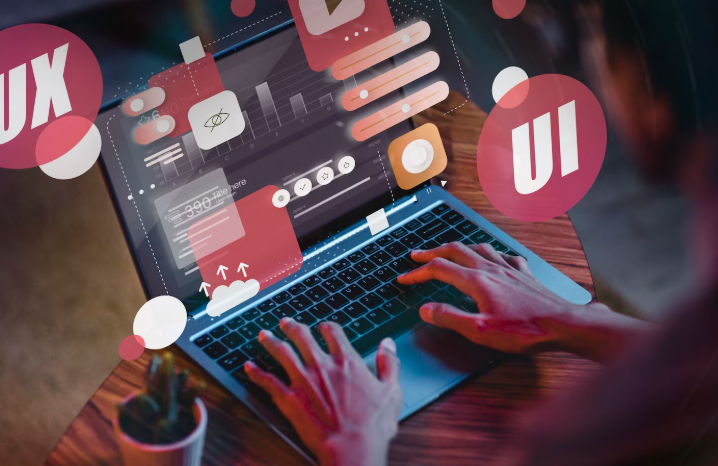As we move deeper into 2025, web design continues to evolve beyond aesthetics—embracing immersive interactions, personalized experiences, and sustainable practices. Businesses that stay ahead of these web design trends will not only look modern but also deliver high-performing, accessible, and engaging experiences. Here are the top 7 design innovations set to dominate this year.
1. Immersive 3D & Motion‑Driven Experiences web design trends
Interactive 3D Elements & Parallax Scrolling
Expect websites to include WebGL-powered 3D models, product spin‑views, and engaging parallax effects. Parallax scrolling—where backgrounds move slower than foregrounds—adds depth and interactivity to storytelling-heavy pages.
Scroll‑Triggered Animations & Micro‑Interactions
Tiny animations (e.g., buttons changing color on hover, elements that fade in on scroll) will continue to delight users and guide them through content. They’re subtle UX boosters tied to conversions and engagement.
2. AI‑Powered Personalization & Chat Functions

Tailored Content Driven by AI
AI and Machine Learning are reshaping UX, delivering content that adapts to user behavior—like product recommendations and dynamic FAQs.
GPT‑Driven Interfaces & Chatbots
Expect sites to integrate conversational AI for real-time interaction, support, and advanced UX writing via Figma-automated content and generative AI tools.
3. Voice User Interfaces (VUI)
Voice‑Search Optimization
With smart assistants like Siri and Alexa becoming standard tools, voice interaction is going mainstream. web design trends must adapt by using conversational UI elements, simplified flows, and SEO-friendly structured data.
4. Mobile‑First and Progressive Web Apps (PWAs)
Mobile‑Only Mindset
More web design trends are shifting from just “responsive” to truly mobile-first design, meaning they’re optimized with mobile users as the priority. This includes large tap targets, minimalistic layouts, and fast load speeds.
Progressive Web Apps
PWAs offer app-like experiences directly from a browser. They support offline access, push notifications, and installability—bridging the gap between mobile apps and web design trends.
5. Dark Mode & Bold Minimalism
Dark Mode as Standard
Dark themes reduce eye strain, save battery, and offer a modern aesthetic. More websites now offer it as default or a toggle option, often preferred by users.
Minimalism with a Twist
web design trends are going clean, but not boring. Expect bold typography, vibrant accent colors, generous whitespace, and simplified interfaces that direct attention without overwhelming the user.
6. Accessibility‑First & Sustainable Design
Inclusive UX
Accessibility is no longer optional. Features like keyboard navigation, high contrast modes, screen reader support, and semantic HTML are essential to ensure digital inclusivity.
Eco‑Conscious web design trends Practices
Fast-loading, lightweight web design trends with clean code reduce energy consumption and server loads. This supports sustainable web development and aligns with green business values.
7. Custom Illustrations, Neumorphism & “Liquid Glass”
Neumorphic & Soft‑UI Aesthetics
Design trends like neumorphism blend minimalism with soft shadows, depth, and realism—often seen in modern dashboard UIs and mobile apps.
AI‑Generated Art & Custom Graphics
Instead of stock images, more brands are using custom illustrations and AI-generated visuals. This creates a unique identity and improves visual storytelling.
Bonus Trend – Augmented Reality (AR) Integration
Interactive & AR Retail Experiences
AR is transforming e-commerce. From virtual try-ons to real estate walkthroughs, users can now interact with products in their environment—boosting confidence and conversion rates.
Why These Trends Matter for Your Business
- Competitive Edge: Immersive visuals and personalization elevate engagement.
- Improved KPIs: Speed, accessibility, and mobile-first design enhance SEO and UX.
- Future-Proofing: Adaptive design, AI, AR, and voice UIs ensure flexibility.
- Brand Perception: Sustainable and accessible design enhances trust and brand value.
Getting Started with 2025’s Web Design Trends
- Audit your current web design trends for performance, UX, and accessibility.
- Prioritize design trends based on your audience and business goals.
- Work with designers and developers who understand the latest tools and standards.
- Test, optimize, and monitor results with real user feedback.
- Keep evolving. web design trends is never a one-time task—it’s an ongoing process.
Final Thought
2025’s web design trends landscape is not just about what looks good—it’s about what works well, feels intuitive, and adapts intelligently. Whether you embrace immersive 3D, AI-driven content, AR experiences, or sustainable coding, one thing is clear: thoughtful design leads to better business.

